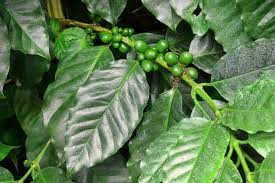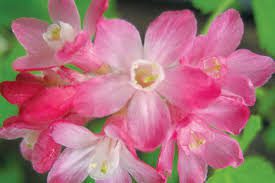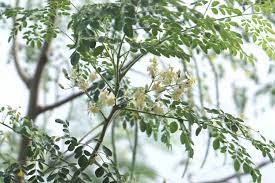Coffee Leaves: Economic Importance, Uses and By-Products
Coffee leaves, scientifically known as Coffea leaves, are the foliage of the coffee plant (genus Coffea) from which coffee beans are harvested. Coffee plants are primarily grown in tropical and subtropical regions around the world, and their leaves are an important part of the plant’s anatomy. Here’s a description of coffee leaves:
Coffee leaves typically have an elongated oval or elliptical shape with pointed tips. They vary in size, but they are usually around 6 to 8 inches in length and 2 to 4 inches in width. The leaves have prominent veins that run parallel to each other from the central midrib outwards. These veins help transport water, nutrients, and photosynthetic products throughout the leaf.
The color of coffee leaves can vary depending on the species, environmental conditions, and the health of the plant. Generally, they are a deep, glossy green, which aids in capturing sunlight for photosynthesis. The surface of coffee leaves is smooth and slightly waxy. This waxy coating, known as the cuticle, helps prevent excessive water loss through evaporation.
Coffee leaves are arranged in an alternating pattern along the stems of the plant. They are attached to the stem by short stalks called petioles. The edges of coffee leaves have a serrated or toothed margin, with small teeth along the edges. The degree of serration can vary among different coffee species.
Coffee leaves, like most plant leaves, consist of several layers. The uppermost layer is the epidermis, followed by the palisade mesophyll (where most of the photosynthesis occurs), the spongy mesophyll (which aids in gas exchange), and the lower epidermis.
Coffee leaves play a crucial role in the process of photosynthesis. They contain chloroplasts, which contain chlorophyll, the pigment responsible for capturing light energy. Through photosynthesis, coffee leaves convert light energy, carbon dioxide, and water into sugars and oxygen, providing energy for the plant’s growth and development.
Coffee leaves can change color under various conditions. Younger leaves might have a lighter, more vibrant green color, while older leaves can turn darker green. Yellowing or browning of leaves can indicate nutrient deficiencies, diseases, or other stress factors.
Coffee leaves are vital to the coffee plant’s ability to thrive and produce coffee beans. Their role in photosynthesis sustains the energy needed for the plant’s growth and, in turn, contributes to the eventual production of the beloved coffee beverage.
The Economic Importance and Uses of Coffee Leaves

Coffee leaves, though not as commonly recognized as coffee beans, also have several economic and practical uses.
Here are some of the economic importance and uses of coffee leaves:
1. Agroforestry and Shade: Coffee leaves are often used in agroforestry systems as shade cover for coffee plants. The leaves provide a natural canopy that helps regulate temperature and humidity, creating a favorable microclimate for coffee cultivation. This practice promotes sustainable and environmentally friendly coffee farming, leading to higher quality coffee beans and reduced need for synthetic fertilizers.
2. Mulch and Compost: Coffee leaves can be collected and used as organic mulch or added to compost piles. When used as mulch, they help retain soil moisture, suppress weed growth, and gradually release nutrients as they decompose, enhancing soil fertility. As compost material, coffee leaves contribute to the nutrient content of the soil, reducing the reliance on chemical fertilizers.
3. Livestock Feed: In some regions, coffee leaves are used as fodder for livestock. While they should be fed in moderation due to their caffeine content, coffee leaves can provide a supplemental food source for animals, especially during times when other forage may be limited.
4. Natural Pesticide and Fertilizer: Coffee leaves contain compounds that have been studied for their potential use as natural pesticides. Extracts from coffee leaves have shown insecticidal properties against certain pests, reducing the need for synthetic chemical pesticides. Additionally, coffee leaves can be used to create nutrient-rich liquid fertilizers through compost tea brewing methods.
5. Traditional Medicine: In various cultures, coffee leaves have been used for their potential medicinal properties. They are believed to have antioxidant and anti-inflammatory effects, and in some regions, they are used to make traditional herbal teas for various health benefits.
Read Also: Coffee Stems: Economic Importance, Uses and By-Products
6. Cultural and Traditional Uses: In some societies, coffee leaves hold cultural and traditional significance. They might be used in ceremonies, rituals, or even as decoration for certain occasions.
7. Research and Pharmaceuticals: Coffee leaves contain a range of bioactive compounds that could have potential applications in the pharmaceutical and cosmetic industries. Research into these compounds may yield new insights into their medical and cosmetic properties.
8. Educational and Awareness Initiatives: Coffee leaves can be utilized in educational programs to teach people about coffee cultivation, sustainability, and the interconnectedness of ecosystems. They can also serve as a visual aid for explaining concepts related to plant biology and agroforestry.
9. Tourism and Experiential Activities: Coffee farms and plantations often offer guided tours to visitors. During these tours, participants might have the opportunity to learn about coffee leaves, their role in the coffee ecosystem, and engage in hands-on activities like leaf collection or composting.
10. Crafts and Art: Coffee leaves can be used for artistic and craft purposes. They can be pressed and dried to create intricate designs or used as natural decorative elements in various artistic projects.
The Products and By-products That Can Be Derived From Coffee Leaves

Coffee leaves, which are often overlooked compared to coffee beans, have several potential uses and can yield various products and by-products.
Here are some examples:
1. Tea or Infusion: Dried coffee leaves can be used to make a caffeine-free herbal tea or infusion. This tea has a mild flavor and is often considered to have potential health benefits due to its antioxidant content.
2. Supplements and Extracts: Coffee leaf extracts can be used in the production of dietary supplements, powders, or liquid extracts. These products might contain beneficial compounds like chlorogenic acids, which are known for their antioxidant and potential health-promoting properties.
3. Cosmetics and Skincare Products: Extracts from coffee leaves can be incorporated into skincare products due to their antioxidant content. These extracts might be used in creams, lotions, serums, or masks for their potential benefits in promoting healthy skin.
4. Food Additives: Compounds extracted from coffee leaves, such as polyphenols, could be used as natural food additives to enhance the antixidant content of various food products.
5. Natural Dyes: The leaves could potentially be used as a source of natural dyes for fabrics and textiles, producing shades of green and brown.
Read Also: Buy your Hybrid Coffee Seedlings
6. Animal Feed: Coffee leaves could be used as a component of animal feed due to their potential nutritional content. However, care must be taken to ensure that any potential caffeine content does not negatively affect animals.
7. Compost and Fertilizer: Coffee leaves can be composted to create nutrient-rich organic matter that can be used as fertilizer for plants.
8. Mulch: Dried coffee leaves can be used as a natural mulch in gardening to help retain moisture, suppress weeds, and improve soil quality.
9. Biofuels: While not as common, research has explored the possibility of using coffee leaves as a potential source of biofuels. The leaves contain cellulose and other organic materials that could be converted into bioenergy.
10. Natural Insecticides and Fungicides: Extracts from coffee leaves could have potential applications as natural insecticides or fungicides in agricultural settings.
11. Paper and Fiber: The cellulose content of coffee leaves could potentially be used in the production of paper, fiber, or other bio-based materials.
In conclusion, it is important to note that while coffee leaves offer various potential uses, their application varies based on regional practices, scientific research, and local traditions. Proper management and sustainable harvesting practices are essential to ensure the long-term viability of these uses while supporting the health of coffee ecosystems.
Read Also: How to Establish and Grow a Waste Management Business









